Harvard Athletics 1870-1914
The following article is adapted from Samuel Elliott Morrison’s 1936 work: Three Centuries of Harvard 1636-1936. Although the period Morrison discusses here, 1870-1914 widely overlaps FDR’s time at the College, the trends he describes very much shaped the athletic world FDR knew, and actively participated in while at Harvard.
Harvard Athletics 1870-1914
The spontaneous growth of athletics was the most astounding phenomenon of student life, to the old-timers, in the first fifteen years of Elioťs administration [beginning in 1869]. The beginnings of rowing and baseball in the 1850s and 60’ we have already seen. The old rough-and-tumble football games between freshmen and sophomores were forbidden in 1860; ‘Boston football,’ a new game, began to be played by class teams in 1871, and the Harvard University Football club was organized in Holden Chapel on December 3, 1872, with Bob Grant ’73 as president. A committee including Charlie Prince ’73 and his brother Morton ’75 proceeded to codify the rules that had grown up more or less spontaneously in Boston schoolboy contests. These rules were somewhat like those of English Rugby; but in the meantime Yale, Columbia, and other colleges were developing a rudimentary soccer. It was a toss-up which would become the American game until 1874, when the H.U.F.B.C. received a challenge from the Foot-ball Club of McGill University to play a series of Rugby matches; and it was agreed that the first should be under the Harvard rules, and the second under McGill’s modified English Rugby rules. The first match of three games (periods) was played on Jarvis Field on May 14, 1874. Originally there were to be fifteen men on a side, but the number was reduced to eleven because four of the McGill men were unable to leave Montreal.
The Canadians wore neat striped jerseys and caps, shaming the Harvardian dark pants,white undershirt, and magenta handkerchief; but Harvard contributed some ‘plays ‘ unknown to English Rugby, which enabled them to win the first match, and to hold McGill to a scoreless tie in the second. The ‘gate’ of a few hundred dollars was pleasantly spent in giving the Canadians a champagne banquet at the Parker House.
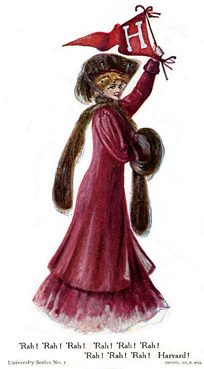
A return match which the H.U.F.B.C. played at Montreal in October weaned Harvard from her peculiar Boston rules to the game from which American football has developed. Tufts College took it up and trounced Harvard the following June; in the fall of 1875 Yale was converted, and defeated. The first^ Harvard-Yale football game was played on November 13, 1875, at New Haven, [where about a hundred and fifty Harvard student were on hand to see their team win by four goals and four touchdowns. It had been better to have been more moderate, for Yale made a determined and successful effort to learn more than her teacher. Walter Camp began to play in 1878; and Harvard did not beat Yale again until 1890. The following description from the Harvard Herald of the first half of the Harvard-Yale football game of 1882 is typical:
The eleven played its last game of the season on Holmes field Saturday, and received its first defeat. Although a cold wind blew down the field promising much inconvenience to spectators, about 2,500 people were grouped around the lines at 2:15 when the teams came on the field. Yale won the toss and chose the wind, Harvard kicking off.The ball was passed back and sent on to Yale’s ground by Mason’s kick and Morison’s rush. Soon, however, Yale’s half-back, taking advantage of the wind, sent the ball by a high punt far into Harvard’s territory, and Hull receiving the ball from a down carried it over our line by a pretty rush and scored a touchdown, but no goal was kicked. Yale now commenced the contemptible game she resorted to last fall, and in a few minutes nearly every man in her rush line was warned and threatened with disqualification either for foul tackling or for jumping on and fouling the backs. It was an exhibition which will be long remembered at Harvard and by the outsiders as well, who came expecting to see a scientific game of football. Wesselhoeft sprained his ankle in one of the roughest scrimmages, and Adams, ’86, took his place. Yale soon scored a touch down through Beck, from a fumble by one of our rush; but Richards again failed in the goal. Harvard then rallied, and brilliant rushing by Morison and Appleton carried the ball into the middle of the field, when time was called.
The ‘fouling the backs’ complained of was the beginning of interference; but Harvard had no right to ‘kick,’ because her initial victory over McGill had been won by springing new plays that were neither forbidden nor anticipated by the Rugby rules. This constant innovation has been the genius and the bane of the American game, for the almost invisible line between clever tactics and foul play made the temptation to unsportsmanlike conduct almost irresistible, and hard feeling between contestants an inevitable concomitant.
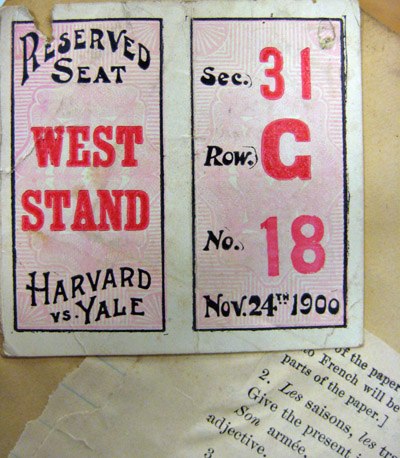
A ticket to the Harvard Yale Game of 1900. (How much more fun a pastime than the French exam glimpsed just behind it!) This would have been FDR’s first classic contest, and he was almost surely there. An interesting historical side note: the tickets were embossed with raised match strikers on the back – ever so much more convenient to light the ubiquitous student pipe! From the scrapbook of Clement Scott, Harvard University Archives.
But the boat races as well engendered ill feeling. The surviving reports, protocols, and pieces justificative! on the Harvard-Columbia ‘race’ of 1882, when, owing to a dispute as to the hour, Columbia rowed down the Thames alone, were worthy of a peace conference; the question of what to do about the Yale shell being a foot longer than the Harvard one was for long the great Eastern Question. The essential cause of this unsportsmanlike bickering — which Oxford and Cambridge had already outgrown — was the desperate desire for notoriety and victory that still trails its slimy track over American intercollegiate athletics. Harvard at this period was consistently successful on the river and the diamond; the crew won twelve out of seventeen races with Yale in 1866-82 inclusive, and twenty-one out of thirty-five baseball games with Yale, in the same period. Defeats in baseball occasioned no great grief; but a Yale victory on the river or the football field was a subject for mourning, from the early seventies. Organized cheering — a staccato yelp, not the now classic three long Harvard’s and three times three — was noticed in the Montreal papers as early as the McGill game of 1874; and the slogan ‘Support the team!’ was coined not long after. ‘Encourage the team this fall in every way we can,’ declared the Harvard Herald in its opening number of 1882. ‘Let us help the captain get all the desirable candidates on the field regularly, let us encourage them in their practice games every afternoon by becoming interested spectators.’ ‘Our athletics suffer more from this very same carelessness of her prominent men than from any other cause.’ Herein is an allusion, though not by name, to the famous ‘ Harvard indifference,’ a quality attributed to the undergraduates from the early eighties to the present because they never did ‘ support the team’ anything like one hundred per cent. Their athletes did not water track or sod with tears of bitterness when defeated; and a mask of indifference had to be cultivated to hide the chagrin of successive drubbings by Walter Camp’s teams. Harvard felt a certain loss of manhood in not winning a single football game with Yale in the eighties and only two in the nineties; it was no consolation to have President Eliot prove that the College gained the most students in these valleys of humiliation.
Athletics properly so called, the classic games and contests of the ancient world, began at Harvard as a sideshow to the boat races. At the intercollegiate regatta at Saratoga in 1874 there were four running races, and a seven-mile walk. In October, 1874, the Harvard Athletic Association was formed, with Benjamin R. Curtis ’75 as president. This body, made up entirely of undergraduates, took charge of running, leaping, boxing, wrestling, and gymnastic competitions for almost twenty years. By that time American usage had extended ‘athletics’ to include all manner of games and contests; athletics in the Greek sense were given the ugly qualification ‘ track.’
Informal track meets were held by the H.A.A. on Jarvis Field from 1874; A. Lawrence Lowell ’77 hung up the first mile and half-mile records. Oarsmen and others competed in the regatta game; but the great event was the formation of the Intercollegiate Association of Amateur Athletes of America in 1876. That summer the Association conducted the last regatta track meet at Saratoga; the next year the winged sandal broke away from the sweep and rudder, and the intercollegiate meets at Mott Haven began. Princeton won the first, and Columbia the next two; there was not much interest in running at Harvard until Everet J. Wendell ’82 entered College, and the first cinder track was built around Jarvis Field in 1879. Wendell was not only a remarkable performer (he ran the ‘hundred’ in ten flat before the crouching start was invented), but a born leader; and Harvard won the intercollegiate meet of 1880 by an overwhelming margin, Wendell alone scoring three firsts. Then, and for ten years more, an amusing feature of these meets was high-wheel bicycles. There was a bicycle club in College from around 1875 to 1890 that made long runs into the country on high wheels—even to Peterborough, New Hampshire, on one occasion.
Cricket was played at Harvard into the present century. Lacrosse and lawn tennis were introduced in the seventies; but as these never became ‘major sports,’ little of their history has been preserved.
The University began to take the physical welfare of her students more seriously. The Hemenway Gymnasium, the gift of a student only three years out of College, was completed in 1878, and the year following Dudley A. Sargent (A.B. Bowdoin, M.D. Yale) was appointed Assistant Professor of Physical Training and Director of the Gymnasium. ‘During the forty years in which he held the position he exerted a greater influence on the development of physical training in American colleges and schools than any other man.’ Under his impetus, and with the new equipment, the H.A.A. went in strongly for gymnastics. At the spring meet in 1881, state the newspapers, ‘every available position in the huge building was taken,’ and the performance had to be repeated to serve public curiosity. There were fifty-six entries in ten events, and some of the aerial acts, especially Dr. Sargent’s famous stunt of sitting in a rocking-chair on a swinging trapeze, ‘were thrilling enough to blanch the cheeks of the ladies.’ That year, Dr. Sargent organized his famous private school of physical culture, which after his death became a department of Boston University.
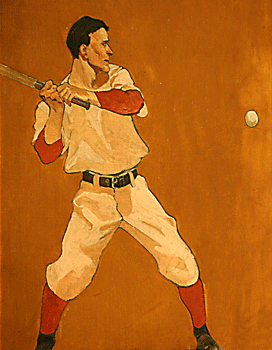
Home run! A small section of one of the spectacular Edward Penfield murals in Randolph Hall, Adams House. Penfield, the premiere cover artist for Harper’s Bizarre, painted scenes of Harvard life for the Randolph Hall breakfast room in 1897.
President Eliot in his report for 1881 declared games and sports to be ‘of great advantage to the University,’ not only because ‘the ideal student [had] been transformed from a stooping, weak, and sickly youth into one well-formed, robust, and healthy,’ but because ‘ the perseverance, resolution and self-denial necessary to success in athletic sports turn out to be qualities valuable in business and other active occupations of after life.’ The H.A.A. and the University Baseball, Football, and Boat Clubs chose their own student officers, engaged professional trainers, took in the exiguous gate receipts of the period, expended them as they chose, and made their own schedules. There were no eligibility rules, except that a player must be enrolled in some department of the University; of the numerous law students on the Harvard baseball teams in the eighties a number were professionals. whose tuition fees as ‘law students’ were paid by ‘patriotic’ old grads., but who never opened a law book. ‘We had four professionals on our baseball team in 1888,’ an old grad. told me. ‘Yale had five, and Princeton, six.’ Men played on the varsity for six or seven years. But it was the alarming length of the baseball schedule of 1882 — twenty-eight games, nineteen of them away from Cambridge — that precipitated a reluctant Faculty into a policy of oversight and regulation that for nigh fifty years afforded that learned body more grief than any learned subject. They appointed a committee of five, under the chairmanship of the aesthetic Norton, but including Dr. Sargent and Adams and Agassiz of the Corporation, to regulate athletic sports; and this committee adopted five rules that are the basis of our athletic regulations today:
- College teams and athletic clubs to compete only with amateurs
- No trainers or coaches to be employed without authority from the Committee
- Nobody to take part in contests except after examination by the Physical Director
- All games outside Cambridge to be played on Saturday
- All oarsmen to pass a swimming test before going on the river
The first thing that the Athletic Committee did was to send the professional football trainer packing and forbid coaching except by amateurs. This did not please the players; and in the winter of 1890-91 the H.U.B.B.C. hired Kelley and Clarkson, the Boston Nationals” $10,000 battery,’ to coach them secretly in the loft over the police station in Brattle Square. By the turn of the century the Faculty had been brought around to the viewpoint that Harvard students were entitled to professional teaching in sports as in studies; and from that time there has been an increasing staff of competent professional coaches in all major sports.
Our first Athletic Committee was discharged in 1885, and a new one constituted by the Governing Boards, to consist of the Physical Director as chairman, a physician (Dr. Henry P. Walcott, A.B. 1858, held that seat for many years), a young graduate who had been an athlete (James J. Storrow, A.B. 1885, was the first), and twenty undergraduates (Charles Francis Adams ’88, the future Secretary of the Navy, and Walter B. Phillips ’86 were the first two). Except for the addition of more members in 1888 to make three each from Faculty, graduates, and undergraduates, the organization of this committee has been unchanged to the present day. Over the H.A.A. (reorganized in 1893 to include all undergraduates who paid a dollar a year) the Athletic Committee appointed a salaried graduate manager (later called graduate treasurer) as executive officer. He, in turn, was superseded in 1926 by a Director of Athletics (William J. Bingham, A.B. 1916), appointed by the Corporation, and now a member of the Faculty of Arts and Sciences. The H.A.A. no longer exists, although the term is still used for ‘Bill’ Bingham and his clerical staff; the Athletic Committee, which is his constitutional cabinet, approves all captains, coaches, and schedules; finances are handled through the College Treasury.
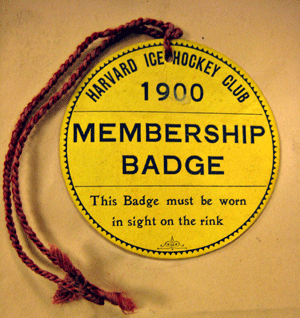
Until 1890, the athletic centre of Harvard was the area north of Kirkland Street and east of Massachusetts Avenue: Holmes Field (now almost completely covered with buildings) and Jarvis Field (the free part of which is now laid out in tennis courts). Additional football grids and baseball diamonds are laid out behind Divinity Hall; the Ca rey (now called the Rotch) Building, erected in 1889, contained an indoor baseball cage, hand-ball courts, and a rowing tank. But in 1890 the University received a new site for her sports, the magnificent gift of thirty-one acres from Major Henry L. Higginson (1855), named Soldiers Field in memory of six of his Harvard comrades who fell fighting for the Union. It was dedicated on June 10 1890, with one of the Major’s simple, manly addresses, concluding with words that we need constantly to remember:
Mates, the Princeton and the Yale fellows are our brothers. Let us beat them fairly if we can, and believe that they will play the game just as we do. Gentlemen, will you remember that this new playground will only be good if it is used constantly and freely by you all, and that it is a legacy from my friends to the dear old College, and so to you? Major Higginson was a great gentleman, and a noble benefactor to Boston and to his University. Let us spare a thought for him, whenever we play on or visit that great lovely plain, bordered by the sunset and other irreclaimable gifts of the sky and landscape, and set forever there in memory of valor and of love.
Unconsciously men were training to be soldiers on Soldiers Field. The first war flurry in twenty years came with President Cleveland’s Venezuela message in 1895. Harvard students at that time were not particularly interested in public affairs, but the prospect of war brought a flood of meetings, pro and anti-administration, and a notable exchange of views in the Crimson between Theodore Roosevelt and William James. The one wrote down the President’s critics as victims of ‘stock-jobbing timidity’ and ‘colonial dependence on England.’ The other replied, in the true Harvard tradition:
May I express a hope that in this University, if no where else on the continent, we shall be patriotic enough not to remain passive whilst the destinies of our country are being settled by surprise. . . . Let us refuse to be bound over night by proclamation, or hypnotized by sacramental phrases through the day. Let us consult our reason as to what is best, and then exert ourselves as citizens with all our might.
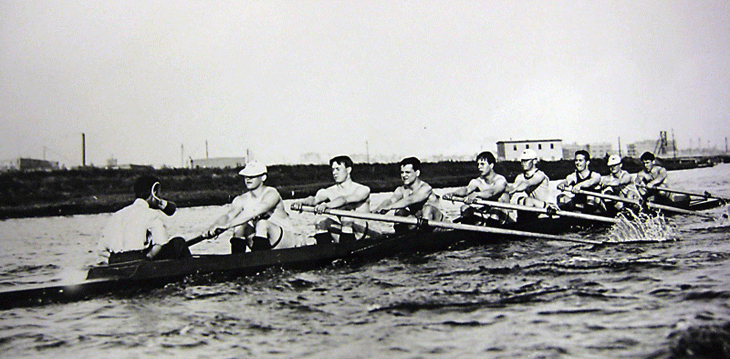
The 1901 second Varsity; for the modern viewer, what’s surprising is how little the sport seems changed, and how much the shoreline has. This view appears to be looking from the Newell back towards Memorial Drive and Harvard Square…
By 1904 (the year that Dartmouth dedicated the new Stadium, inauspiciously) it was clear that if the game and its surroundings were not reformed, the Governing Boards would forbid the College to play it; so a determined effort was made to change the rules of play and of eligibility. In 1906, freshmen, special students and students in the graduate and professional schools were first barred from varsity teams and crews; and the ‘new football’ began. And in the fall of 1908 the glorious Haughton era opened. Percy D. Haughton (A.B. 1899) as head coach built up a football machine that in the next twelve years of play (there were no games in 1917 and 1918) gave us eight victories over Yale (culminating in 41 to nothing by Eddie Mahan’s team in 1915), two scoreless ties, and only two defeats. Haughton was the first of the modern ‘ big-time coaches,’ and he certainly ‘delivered the goods: but it may be questioned whether his talent for picturesque profanity made the game more enjoyable, or whether his strategical and tactical developments turned football in the right direction. Later coaches of other colleges, building on what Haughton began, have made successful football playing a full-time, almost a professional job; and the public have responded with such keen delight that college players are now subjected to the unpleasing publicity that attends a movie star. Gate receipts mounted, so that various expensive developments were undertaken and minor sports became dependent on them; schedules had to be made with a view to the ‘gate’ rather than the game. Except from the viewpoint of ‘grand-stand quarterbacks’ and professional sports writers, the last state of football is worse than the first; and a fresh move for Harvard to withdraw from a game no longer suitable for amateurs was only prevented by the transfer of public attention to professional football.
Until the end of the Eliot administration, the principal emphasis in Harvard athletics was on developing winning teams and crews; others were supposed to look on and cheer. (There was no form of exercise open to the physically ungifted student except tennis and its derivatives, indoor gymnastics, and paddling in a wherry. The ten years from 1907 to the World War brought a great improvement in this respect; and the man to whom it is mostly due is William F. Garcelon (LL.B. 1895), volunteer track coach and graduate treasurer of the H.A.A. Mr. Garcelon, observing that ‘many men . . . needed only a word of encouragement and a bit of instruction to transform them from lookers-on and pipe-smoking idlers to enthusiastic participants,’ gave the same help to gangling hobbledehoys as to ‘ varsity material,’ improving beyond all measure their physique, their morale, and their enjoyment of College. His success, and the intelligent interest of Dr. Roger I. Lee (A.B. 1902), Professor of Hygiene, since 1914, brought about the policy of’ athletics for all. Compulsory exercise for freshmen was instituted in 1919, and by the second decade of the present century it became an exception for Harvard students not to be engaged in some regular form of physical activity. The growth of athletics tended to integrate college life in the Eliot era; participation in them, both as players and as managers, brought together men of the widest social origins, and victory over Yale in the four major’ sports of football, rowing, baseball, and track was something that the entire College prayed for.
